Organizational Behaviour Report: Morrison Case Study Analysis
VerifiedAdded on 2020/10/23
|15
|4682
|475
Report
AI Summary
This report provides a comprehensive analysis of organizational behaviour, focusing on the case study of Morrison, a UK-based online supermarket. The report delves into the influence of organizational culture, politics, and power dynamics on employee performance and team effectiveness. It explores Handy's culture theory to assess the impact of different culture types, including power, task, person, and role cultures. The report also examines the effects of positive and negative organizational politics and different sources of power, such as reward, coercive, legitimate, referent, and expert power, according to Raven and French's framework. Furthermore, it evaluates motivational techniques through content and process theories, including Maslow's hierarchy of needs and Adam's Equity theory. Finally, the report applies Tuckman's team development theory to differentiate between effective and ineffective teams within the Morrison context, offering insights into how these factors impact organizational success.
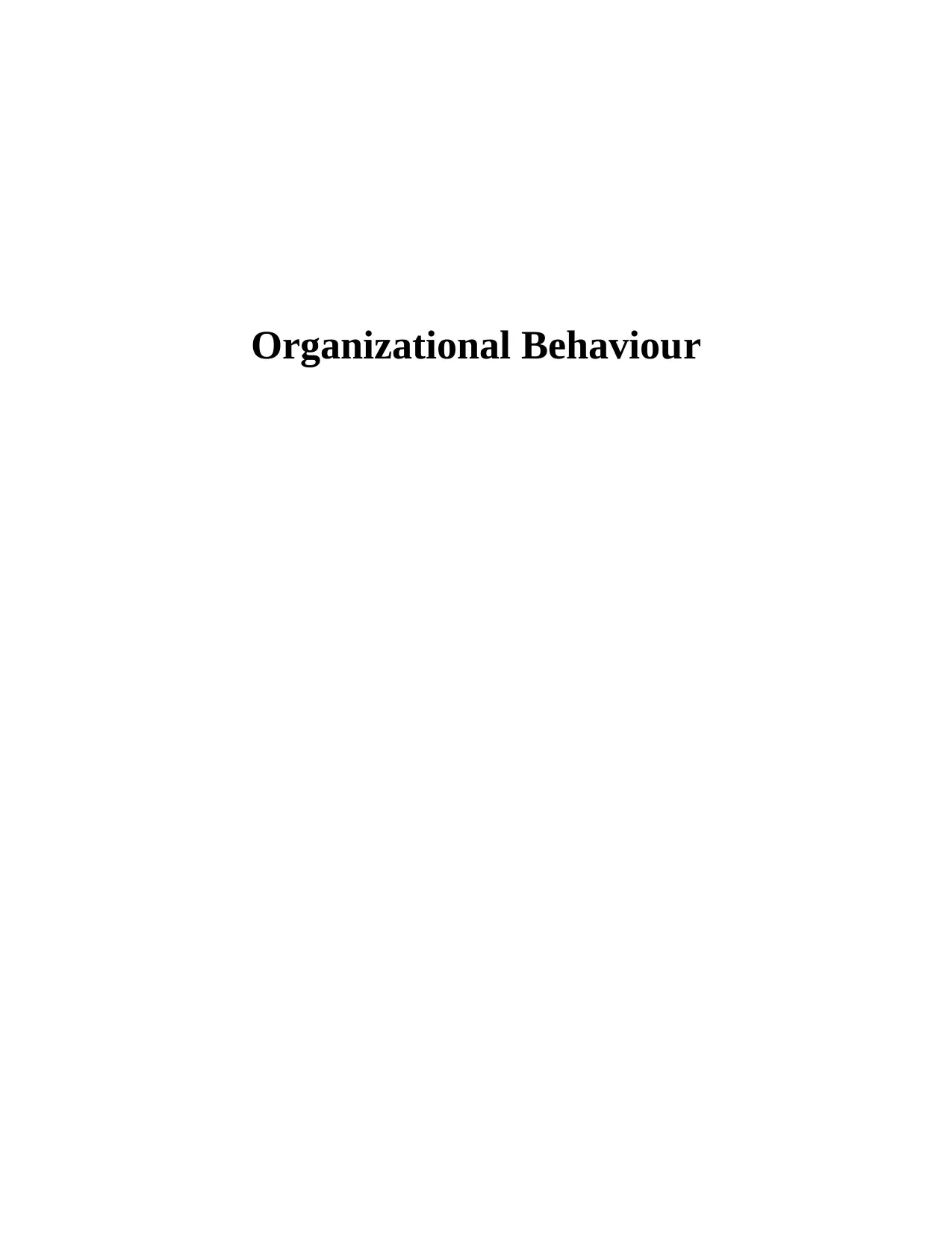
Organizational Behaviour
Paraphrase This Document
Need a fresh take? Get an instant paraphrase of this document with our AI Paraphraser
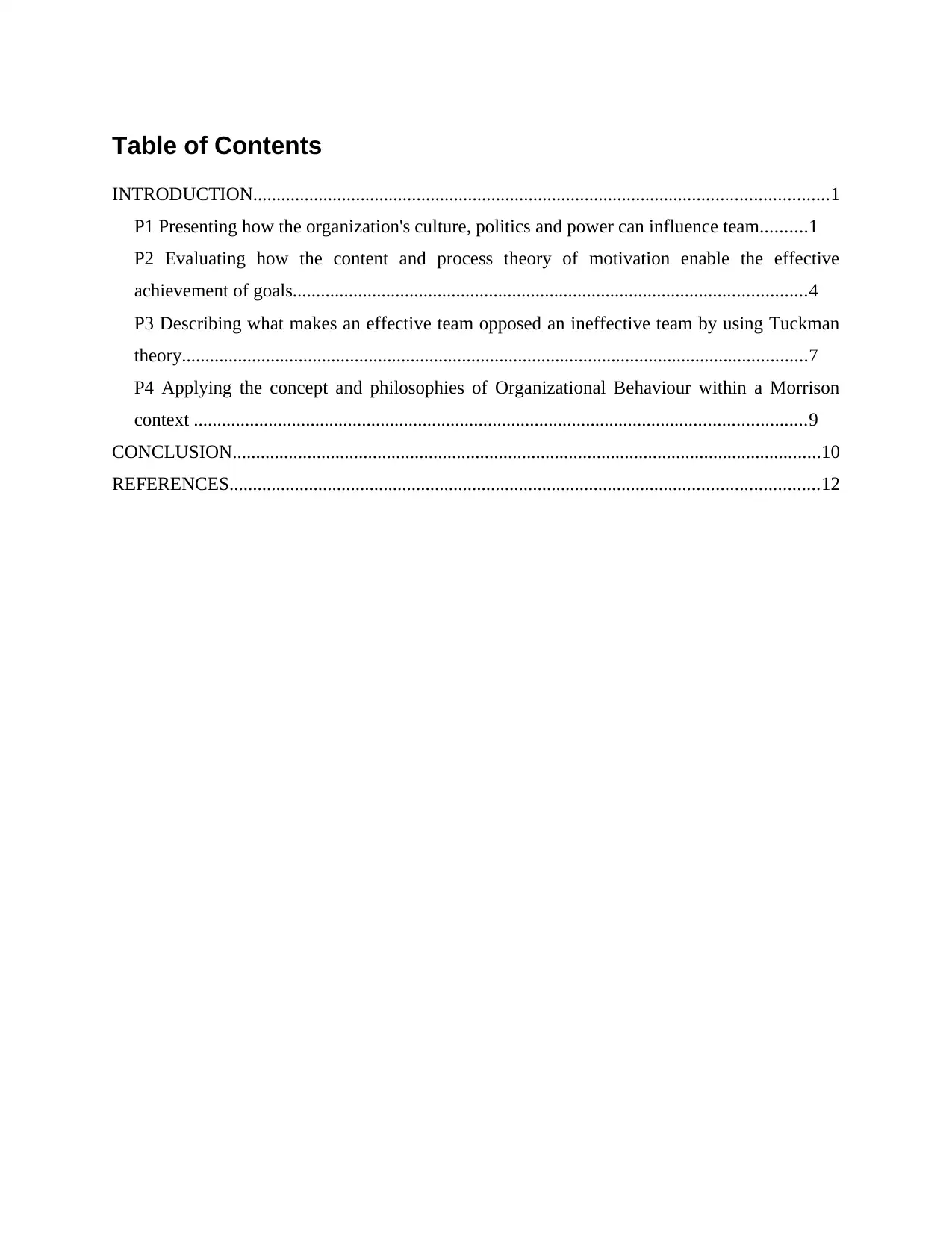
Table of Contents
INTRODUCTION...........................................................................................................................1
P1 Presenting how the organization's culture, politics and power can influence team..........1
P2 Evaluating how the content and process theory of motivation enable the effective
achievement of goals..............................................................................................................4
P3 Describing what makes an effective team opposed an ineffective team by using Tuckman
theory......................................................................................................................................7
P4 Applying the concept and philosophies of Organizational Behaviour within a Morrison
context ...................................................................................................................................9
CONCLUSION..............................................................................................................................10
REFERENCES..............................................................................................................................12
INTRODUCTION...........................................................................................................................1
P1 Presenting how the organization's culture, politics and power can influence team..........1
P2 Evaluating how the content and process theory of motivation enable the effective
achievement of goals..............................................................................................................4
P3 Describing what makes an effective team opposed an ineffective team by using Tuckman
theory......................................................................................................................................7
P4 Applying the concept and philosophies of Organizational Behaviour within a Morrison
context ...................................................................................................................................9
CONCLUSION..............................................................................................................................10
REFERENCES..............................................................................................................................12
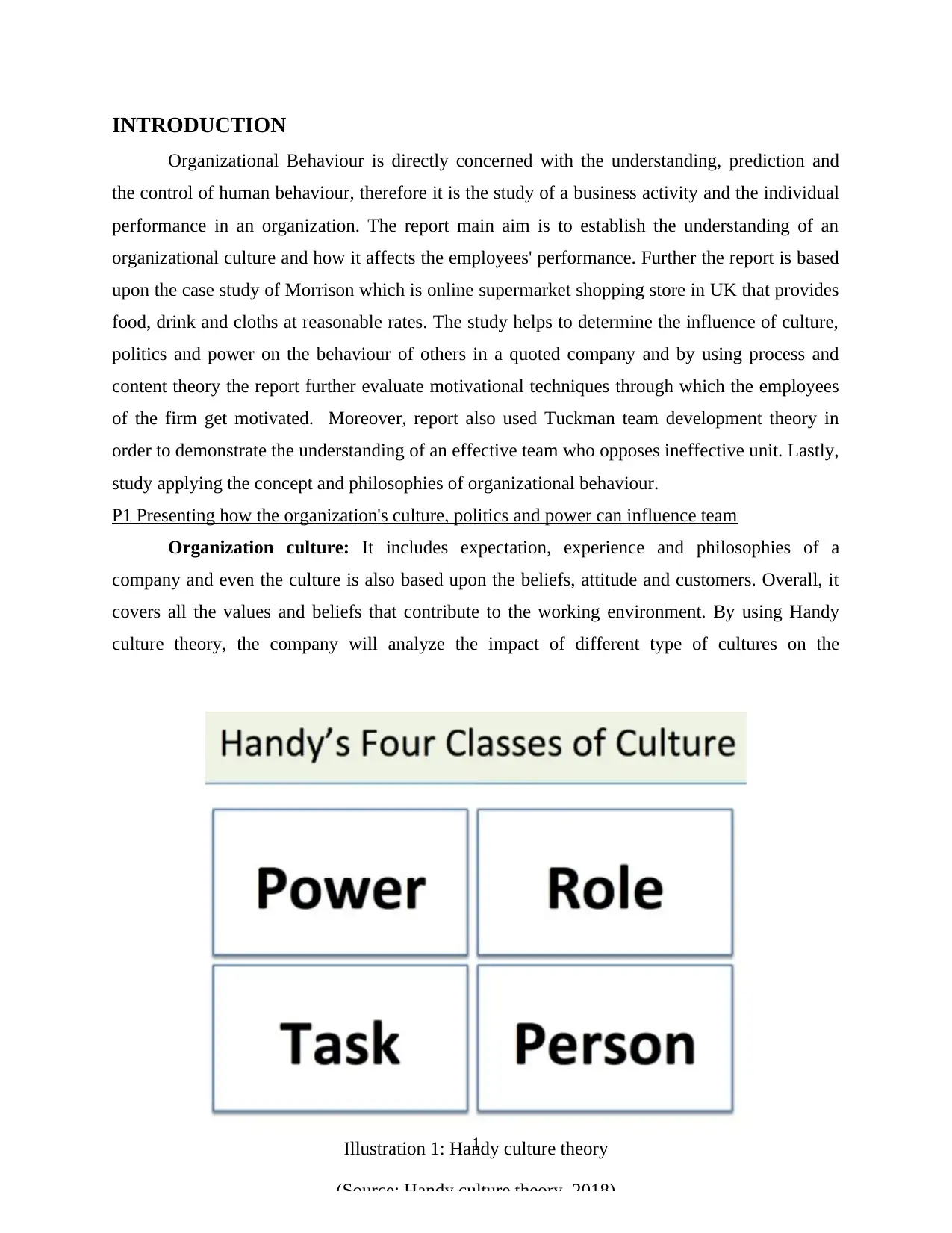
INTRODUCTION
Organizational Behaviour is directly concerned with the understanding, prediction and
the control of human behaviour, therefore it is the study of a business activity and the individual
performance in an organization. The report main aim is to establish the understanding of an
organizational culture and how it affects the employees' performance. Further the report is based
upon the case study of Morrison which is online supermarket shopping store in UK that provides
food, drink and cloths at reasonable rates. The study helps to determine the influence of culture,
politics and power on the behaviour of others in a quoted company and by using process and
content theory the report further evaluate motivational techniques through which the employees
of the firm get motivated. Moreover, report also used Tuckman team development theory in
order to demonstrate the understanding of an effective team who opposes ineffective unit. Lastly,
study applying the concept and philosophies of organizational behaviour.
P1 Presenting how the organization's culture, politics and power can influence team
Organization culture: It includes expectation, experience and philosophies of a
company and even the culture is also based upon the beliefs, attitude and customers. Overall, it
covers all the values and beliefs that contribute to the working environment. By using Handy
culture theory, the company will analyze the impact of different type of cultures on the
1Illustration 1: Handy culture theory
(Source: Handy culture theory, 2018)
Organizational Behaviour is directly concerned with the understanding, prediction and
the control of human behaviour, therefore it is the study of a business activity and the individual
performance in an organization. The report main aim is to establish the understanding of an
organizational culture and how it affects the employees' performance. Further the report is based
upon the case study of Morrison which is online supermarket shopping store in UK that provides
food, drink and cloths at reasonable rates. The study helps to determine the influence of culture,
politics and power on the behaviour of others in a quoted company and by using process and
content theory the report further evaluate motivational techniques through which the employees
of the firm get motivated. Moreover, report also used Tuckman team development theory in
order to demonstrate the understanding of an effective team who opposes ineffective unit. Lastly,
study applying the concept and philosophies of organizational behaviour.
P1 Presenting how the organization's culture, politics and power can influence team
Organization culture: It includes expectation, experience and philosophies of a
company and even the culture is also based upon the beliefs, attitude and customers. Overall, it
covers all the values and beliefs that contribute to the working environment. By using Handy
culture theory, the company will analyze the impact of different type of cultures on the
1Illustration 1: Handy culture theory
(Source: Handy culture theory, 2018)
⊘ This is a preview!⊘
Do you want full access?
Subscribe today to unlock all pages.

Trusted by 1+ million students worldwide
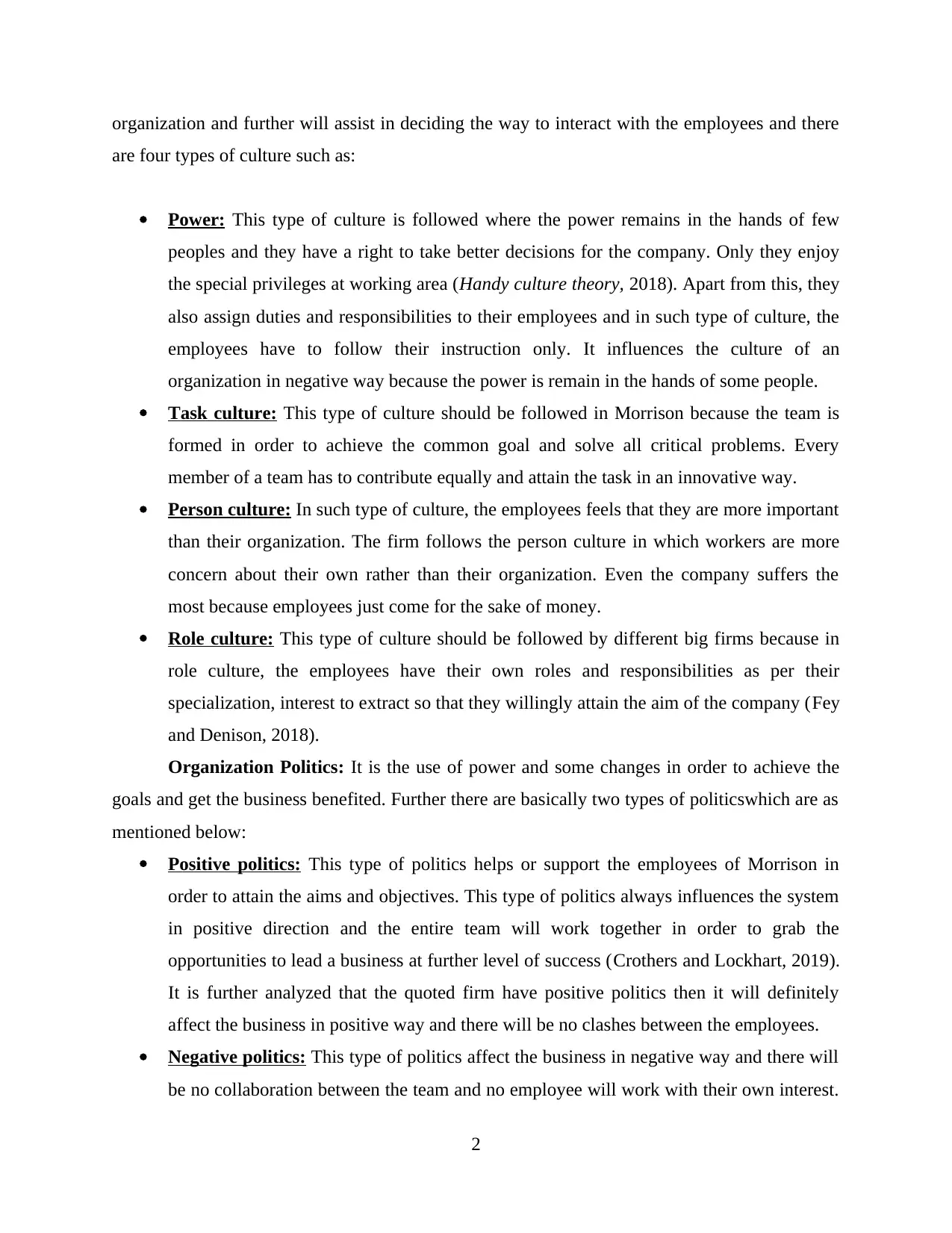
organization and further will assist in deciding the way to interact with the employees and there
are four types of culture such as:
Power: This type of culture is followed where the power remains in the hands of few
peoples and they have a right to take better decisions for the company. Only they enjoy
the special privileges at working area (Handy culture theory, 2018). Apart from this, they
also assign duties and responsibilities to their employees and in such type of culture, the
employees have to follow their instruction only. It influences the culture of an
organization in negative way because the power is remain in the hands of some people.
Task culture: This type of culture should be followed in Morrison because the team is
formed in order to achieve the common goal and solve all critical problems. Every
member of a team has to contribute equally and attain the task in an innovative way.
Person culture: In such type of culture, the employees feels that they are more important
than their organization. The firm follows the person culture in which workers are more
concern about their own rather than their organization. Even the company suffers the
most because employees just come for the sake of money.
Role culture: This type of culture should be followed by different big firms because in
role culture, the employees have their own roles and responsibilities as per their
specialization, interest to extract so that they willingly attain the aim of the company (Fey
and Denison, 2018).
Organization Politics: It is the use of power and some changes in order to achieve the
goals and get the business benefited. Further there are basically two types of politicswhich are as
mentioned below:
Positive politics: This type of politics helps or support the employees of Morrison in
order to attain the aims and objectives. This type of politics always influences the system
in positive direction and the entire team will work together in order to grab the
opportunities to lead a business at further level of success (Crothers and Lockhart, 2019).
It is further analyzed that the quoted firm have positive politics then it will definitely
affect the business in positive way and there will be no clashes between the employees.
Negative politics: This type of politics affect the business in negative way and there will
be no collaboration between the team and no employee will work with their own interest.
2
are four types of culture such as:
Power: This type of culture is followed where the power remains in the hands of few
peoples and they have a right to take better decisions for the company. Only they enjoy
the special privileges at working area (Handy culture theory, 2018). Apart from this, they
also assign duties and responsibilities to their employees and in such type of culture, the
employees have to follow their instruction only. It influences the culture of an
organization in negative way because the power is remain in the hands of some people.
Task culture: This type of culture should be followed in Morrison because the team is
formed in order to achieve the common goal and solve all critical problems. Every
member of a team has to contribute equally and attain the task in an innovative way.
Person culture: In such type of culture, the employees feels that they are more important
than their organization. The firm follows the person culture in which workers are more
concern about their own rather than their organization. Even the company suffers the
most because employees just come for the sake of money.
Role culture: This type of culture should be followed by different big firms because in
role culture, the employees have their own roles and responsibilities as per their
specialization, interest to extract so that they willingly attain the aim of the company (Fey
and Denison, 2018).
Organization Politics: It is the use of power and some changes in order to achieve the
goals and get the business benefited. Further there are basically two types of politicswhich are as
mentioned below:
Positive politics: This type of politics helps or support the employees of Morrison in
order to attain the aims and objectives. This type of politics always influences the system
in positive direction and the entire team will work together in order to grab the
opportunities to lead a business at further level of success (Crothers and Lockhart, 2019).
It is further analyzed that the quoted firm have positive politics then it will definitely
affect the business in positive way and there will be no clashes between the employees.
Negative politics: This type of politics affect the business in negative way and there will
be no collaboration between the team and no employee will work with their own interest.
2
Paraphrase This Document
Need a fresh take? Get an instant paraphrase of this document with our AI Paraphraser
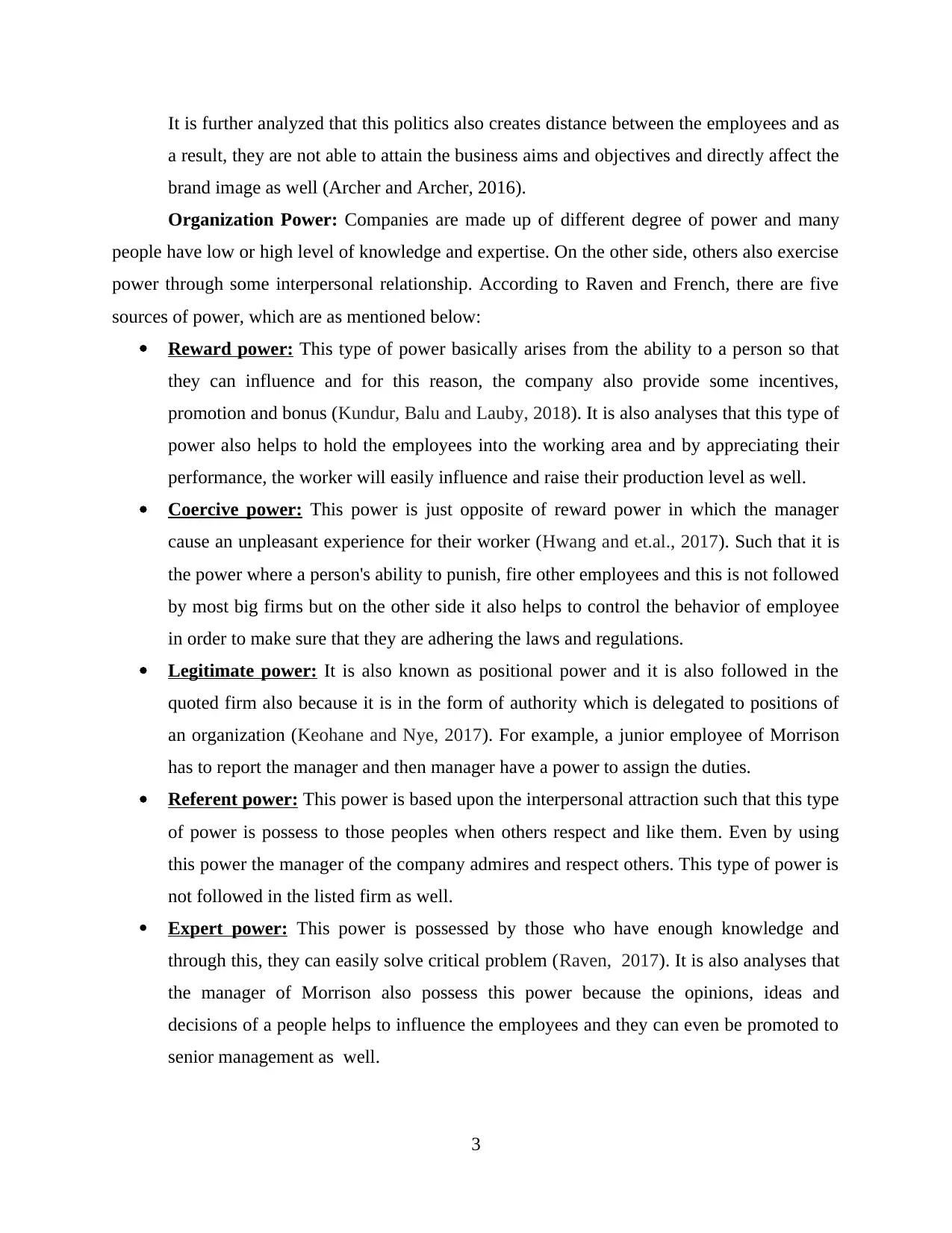
It is further analyzed that this politics also creates distance between the employees and as
a result, they are not able to attain the business aims and objectives and directly affect the
brand image as well (Archer and Archer, 2016).
Organization Power: Companies are made up of different degree of power and many
people have low or high level of knowledge and expertise. On the other side, others also exercise
power through some interpersonal relationship. According to Raven and French, there are five
sources of power, which are as mentioned below:
Reward power: This type of power basically arises from the ability to a person so that
they can influence and for this reason, the company also provide some incentives,
promotion and bonus (Kundur, Balu and Lauby, 2018). It is also analyses that this type of
power also helps to hold the employees into the working area and by appreciating their
performance, the worker will easily influence and raise their production level as well.
Coercive power: This power is just opposite of reward power in which the manager
cause an unpleasant experience for their worker (Hwang and et.al., 2017). Such that it is
the power where a person's ability to punish, fire other employees and this is not followed
by most big firms but on the other side it also helps to control the behavior of employee
in order to make sure that they are adhering the laws and regulations.
Legitimate power: It is also known as positional power and it is also followed in the
quoted firm also because it is in the form of authority which is delegated to positions of
an organization (Keohane and Nye, 2017). For example, a junior employee of Morrison
has to report the manager and then manager have a power to assign the duties.
Referent power: This power is based upon the interpersonal attraction such that this type
of power is possess to those peoples when others respect and like them. Even by using
this power the manager of the company admires and respect others. This type of power is
not followed in the listed firm as well.
Expert power: This power is possessed by those who have enough knowledge and
through this, they can easily solve critical problem (Raven, 2017). It is also analyses that
the manager of Morrison also possess this power because the opinions, ideas and
decisions of a people helps to influence the employees and they can even be promoted to
senior management as well.
3
a result, they are not able to attain the business aims and objectives and directly affect the
brand image as well (Archer and Archer, 2016).
Organization Power: Companies are made up of different degree of power and many
people have low or high level of knowledge and expertise. On the other side, others also exercise
power through some interpersonal relationship. According to Raven and French, there are five
sources of power, which are as mentioned below:
Reward power: This type of power basically arises from the ability to a person so that
they can influence and for this reason, the company also provide some incentives,
promotion and bonus (Kundur, Balu and Lauby, 2018). It is also analyses that this type of
power also helps to hold the employees into the working area and by appreciating their
performance, the worker will easily influence and raise their production level as well.
Coercive power: This power is just opposite of reward power in which the manager
cause an unpleasant experience for their worker (Hwang and et.al., 2017). Such that it is
the power where a person's ability to punish, fire other employees and this is not followed
by most big firms but on the other side it also helps to control the behavior of employee
in order to make sure that they are adhering the laws and regulations.
Legitimate power: It is also known as positional power and it is also followed in the
quoted firm also because it is in the form of authority which is delegated to positions of
an organization (Keohane and Nye, 2017). For example, a junior employee of Morrison
has to report the manager and then manager have a power to assign the duties.
Referent power: This power is based upon the interpersonal attraction such that this type
of power is possess to those peoples when others respect and like them. Even by using
this power the manager of the company admires and respect others. This type of power is
not followed in the listed firm as well.
Expert power: This power is possessed by those who have enough knowledge and
through this, they can easily solve critical problem (Raven, 2017). It is also analyses that
the manager of Morrison also possess this power because the opinions, ideas and
decisions of a people helps to influence the employees and they can even be promoted to
senior management as well.
3
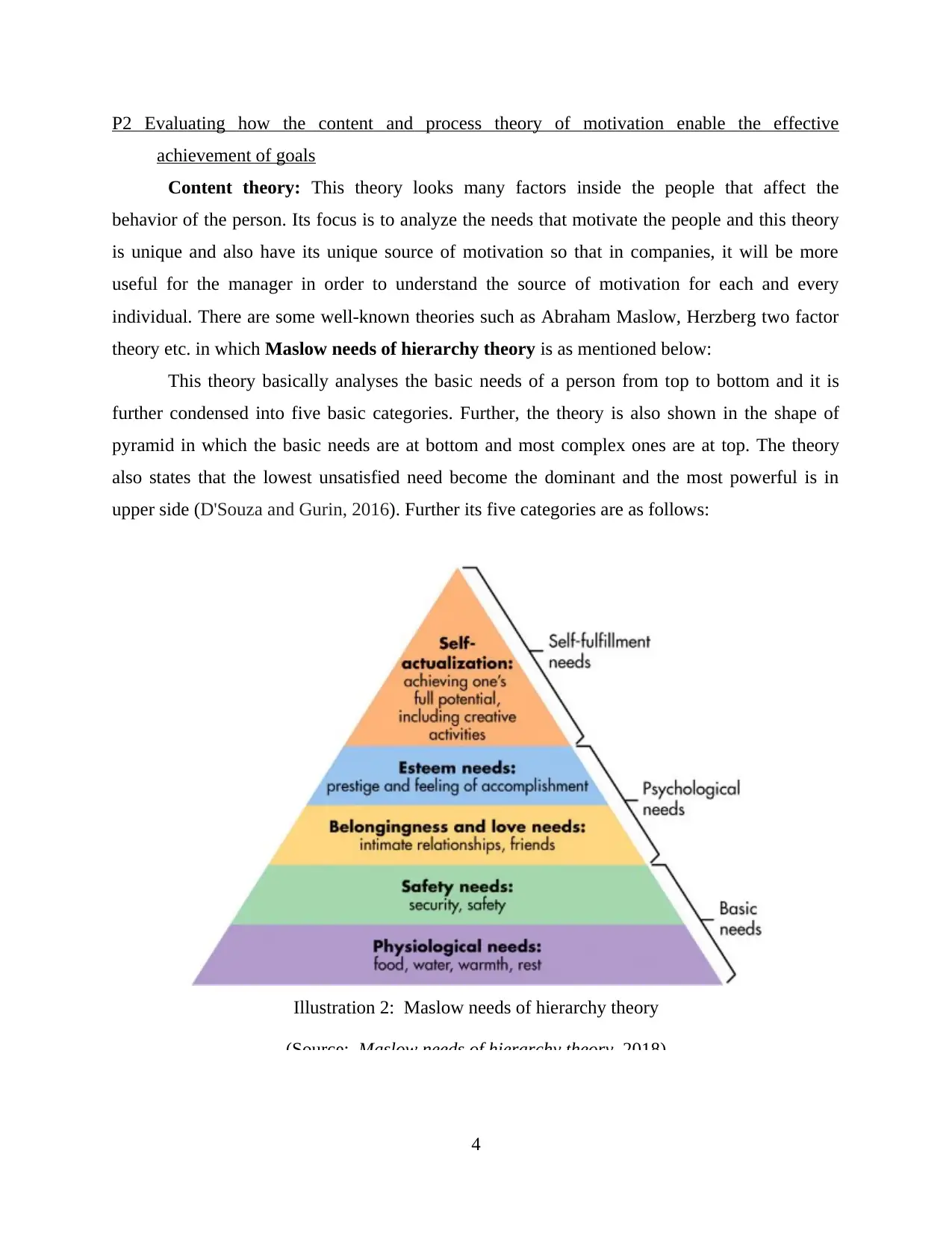
P2 Evaluating how the content and process theory of motivation enable the effective
achievement of goals
Content theory: This theory looks many factors inside the people that affect the
behavior of the person. Its focus is to analyze the needs that motivate the people and this theory
is unique and also have its unique source of motivation so that in companies, it will be more
useful for the manager in order to understand the source of motivation for each and every
individual. There are some well-known theories such as Abraham Maslow, Herzberg two factor
theory etc. in which Maslow needs of hierarchy theory is as mentioned below:
This theory basically analyses the basic needs of a person from top to bottom and it is
further condensed into five basic categories. Further, the theory is also shown in the shape of
pyramid in which the basic needs are at bottom and most complex ones are at top. The theory
also states that the lowest unsatisfied need become the dominant and the most powerful is in
upper side (D'Souza and Gurin, 2016). Further its five categories are as follows:
4
Illustration 2: Maslow needs of hierarchy theory
(Source: Maslow needs of hierarchy theory, 2018)
achievement of goals
Content theory: This theory looks many factors inside the people that affect the
behavior of the person. Its focus is to analyze the needs that motivate the people and this theory
is unique and also have its unique source of motivation so that in companies, it will be more
useful for the manager in order to understand the source of motivation for each and every
individual. There are some well-known theories such as Abraham Maslow, Herzberg two factor
theory etc. in which Maslow needs of hierarchy theory is as mentioned below:
This theory basically analyses the basic needs of a person from top to bottom and it is
further condensed into five basic categories. Further, the theory is also shown in the shape of
pyramid in which the basic needs are at bottom and most complex ones are at top. The theory
also states that the lowest unsatisfied need become the dominant and the most powerful is in
upper side (D'Souza and Gurin, 2016). Further its five categories are as follows:
4
Illustration 2: Maslow needs of hierarchy theory
(Source: Maslow needs of hierarchy theory, 2018)
⊘ This is a preview!⊘
Do you want full access?
Subscribe today to unlock all pages.

Trusted by 1+ million students worldwide
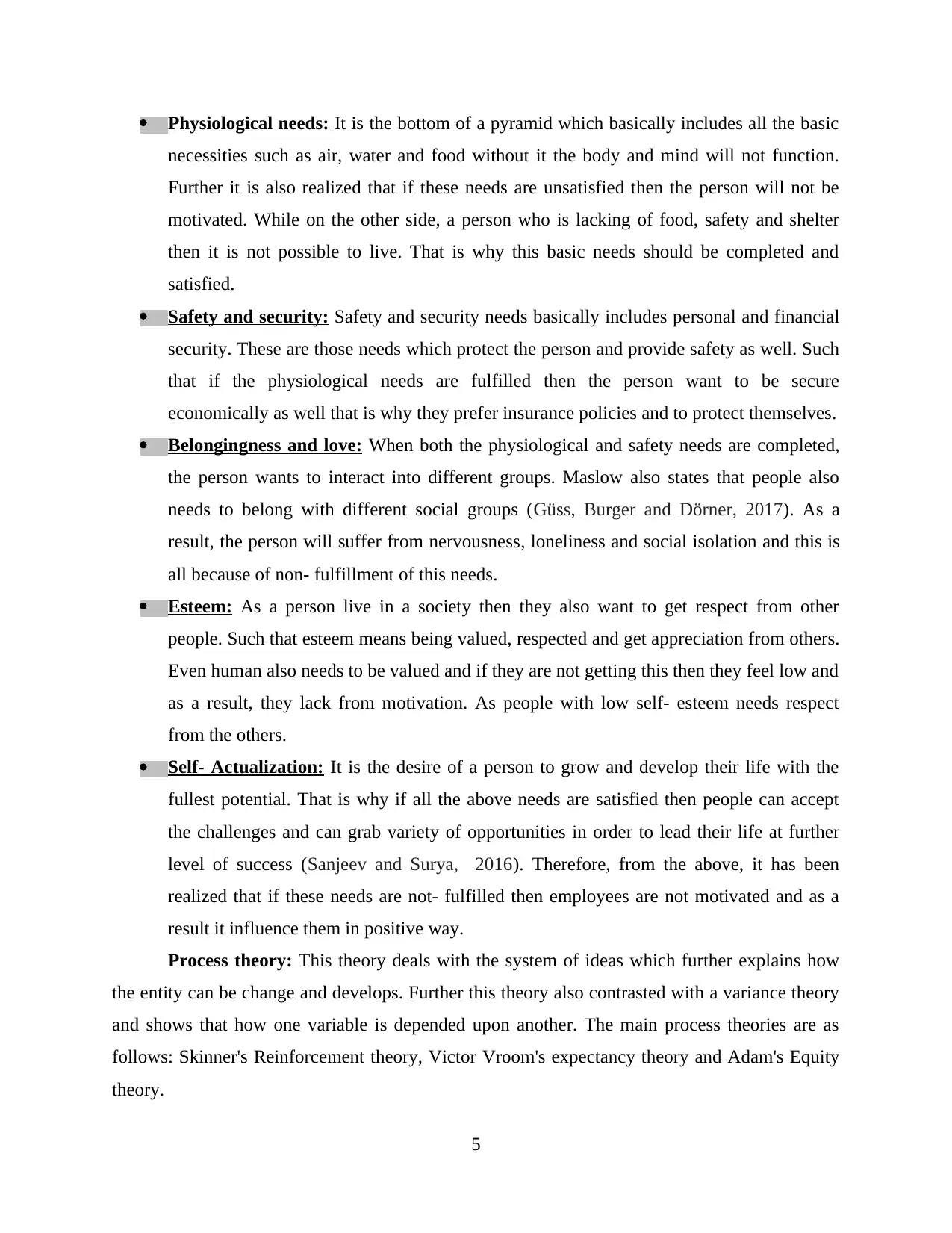
Physiological needs: It is the bottom of a pyramid which basically includes all the basic
necessities such as air, water and food without it the body and mind will not function.
Further it is also realized that if these needs are unsatisfied then the person will not be
motivated. While on the other side, a person who is lacking of food, safety and shelter
then it is not possible to live. That is why this basic needs should be completed and
satisfied.
Safety and security: Safety and security needs basically includes personal and financial
security. These are those needs which protect the person and provide safety as well. Such
that if the physiological needs are fulfilled then the person want to be secure
economically as well that is why they prefer insurance policies and to protect themselves.
Belongingness and love: When both the physiological and safety needs are completed,
the person wants to interact into different groups. Maslow also states that people also
needs to belong with different social groups (Güss, Burger and Dörner, 2017). As a
result, the person will suffer from nervousness, loneliness and social isolation and this is
all because of non- fulfillment of this needs.
Esteem: As a person live in a society then they also want to get respect from other
people. Such that esteem means being valued, respected and get appreciation from others.
Even human also needs to be valued and if they are not getting this then they feel low and
as a result, they lack from motivation. As people with low self- esteem needs respect
from the others.
Self- Actualization: It is the desire of a person to grow and develop their life with the
fullest potential. That is why if all the above needs are satisfied then people can accept
the challenges and can grab variety of opportunities in order to lead their life at further
level of success (Sanjeev and Surya, 2016). Therefore, from the above, it has been
realized that if these needs are not- fulfilled then employees are not motivated and as a
result it influence them in positive way.
Process theory: This theory deals with the system of ideas which further explains how
the entity can be change and develops. Further this theory also contrasted with a variance theory
and shows that how one variable is depended upon another. The main process theories are as
follows: Skinner's Reinforcement theory, Victor Vroom's expectancy theory and Adam's Equity
theory.
5
necessities such as air, water and food without it the body and mind will not function.
Further it is also realized that if these needs are unsatisfied then the person will not be
motivated. While on the other side, a person who is lacking of food, safety and shelter
then it is not possible to live. That is why this basic needs should be completed and
satisfied.
Safety and security: Safety and security needs basically includes personal and financial
security. These are those needs which protect the person and provide safety as well. Such
that if the physiological needs are fulfilled then the person want to be secure
economically as well that is why they prefer insurance policies and to protect themselves.
Belongingness and love: When both the physiological and safety needs are completed,
the person wants to interact into different groups. Maslow also states that people also
needs to belong with different social groups (Güss, Burger and Dörner, 2017). As a
result, the person will suffer from nervousness, loneliness and social isolation and this is
all because of non- fulfillment of this needs.
Esteem: As a person live in a society then they also want to get respect from other
people. Such that esteem means being valued, respected and get appreciation from others.
Even human also needs to be valued and if they are not getting this then they feel low and
as a result, they lack from motivation. As people with low self- esteem needs respect
from the others.
Self- Actualization: It is the desire of a person to grow and develop their life with the
fullest potential. That is why if all the above needs are satisfied then people can accept
the challenges and can grab variety of opportunities in order to lead their life at further
level of success (Sanjeev and Surya, 2016). Therefore, from the above, it has been
realized that if these needs are not- fulfilled then employees are not motivated and as a
result it influence them in positive way.
Process theory: This theory deals with the system of ideas which further explains how
the entity can be change and develops. Further this theory also contrasted with a variance theory
and shows that how one variable is depended upon another. The main process theories are as
follows: Skinner's Reinforcement theory, Victor Vroom's expectancy theory and Adam's Equity
theory.
5
Paraphrase This Document
Need a fresh take? Get an instant paraphrase of this document with our AI Paraphraser
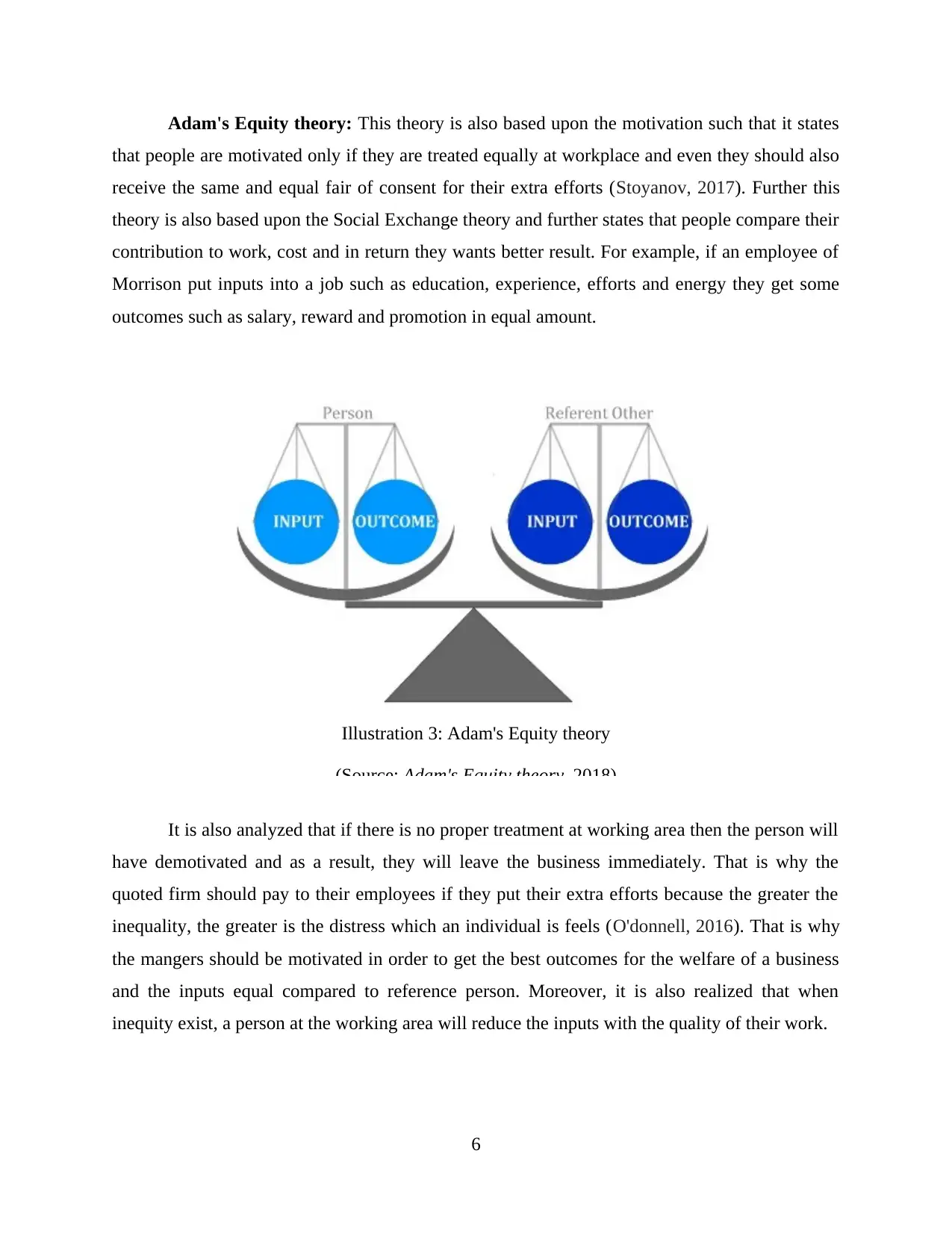
Adam's Equity theory: This theory is also based upon the motivation such that it states
that people are motivated only if they are treated equally at workplace and even they should also
receive the same and equal fair of consent for their extra efforts (Stoyanov, 2017). Further this
theory is also based upon the Social Exchange theory and further states that people compare their
contribution to work, cost and in return they wants better result. For example, if an employee of
Morrison put inputs into a job such as education, experience, efforts and energy they get some
outcomes such as salary, reward and promotion in equal amount.
It is also analyzed that if there is no proper treatment at working area then the person will
have demotivated and as a result, they will leave the business immediately. That is why the
quoted firm should pay to their employees if they put their extra efforts because the greater the
inequality, the greater is the distress which an individual is feels (O'donnell, 2016). That is why
the mangers should be motivated in order to get the best outcomes for the welfare of a business
and the inputs equal compared to reference person. Moreover, it is also realized that when
inequity exist, a person at the working area will reduce the inputs with the quality of their work.
6
Illustration 3: Adam's Equity theory
(Source: Adam's Equity theory, 2018)
that people are motivated only if they are treated equally at workplace and even they should also
receive the same and equal fair of consent for their extra efforts (Stoyanov, 2017). Further this
theory is also based upon the Social Exchange theory and further states that people compare their
contribution to work, cost and in return they wants better result. For example, if an employee of
Morrison put inputs into a job such as education, experience, efforts and energy they get some
outcomes such as salary, reward and promotion in equal amount.
It is also analyzed that if there is no proper treatment at working area then the person will
have demotivated and as a result, they will leave the business immediately. That is why the
quoted firm should pay to their employees if they put their extra efforts because the greater the
inequality, the greater is the distress which an individual is feels (O'donnell, 2016). That is why
the mangers should be motivated in order to get the best outcomes for the welfare of a business
and the inputs equal compared to reference person. Moreover, it is also realized that when
inequity exist, a person at the working area will reduce the inputs with the quality of their work.
6
Illustration 3: Adam's Equity theory
(Source: Adam's Equity theory, 2018)
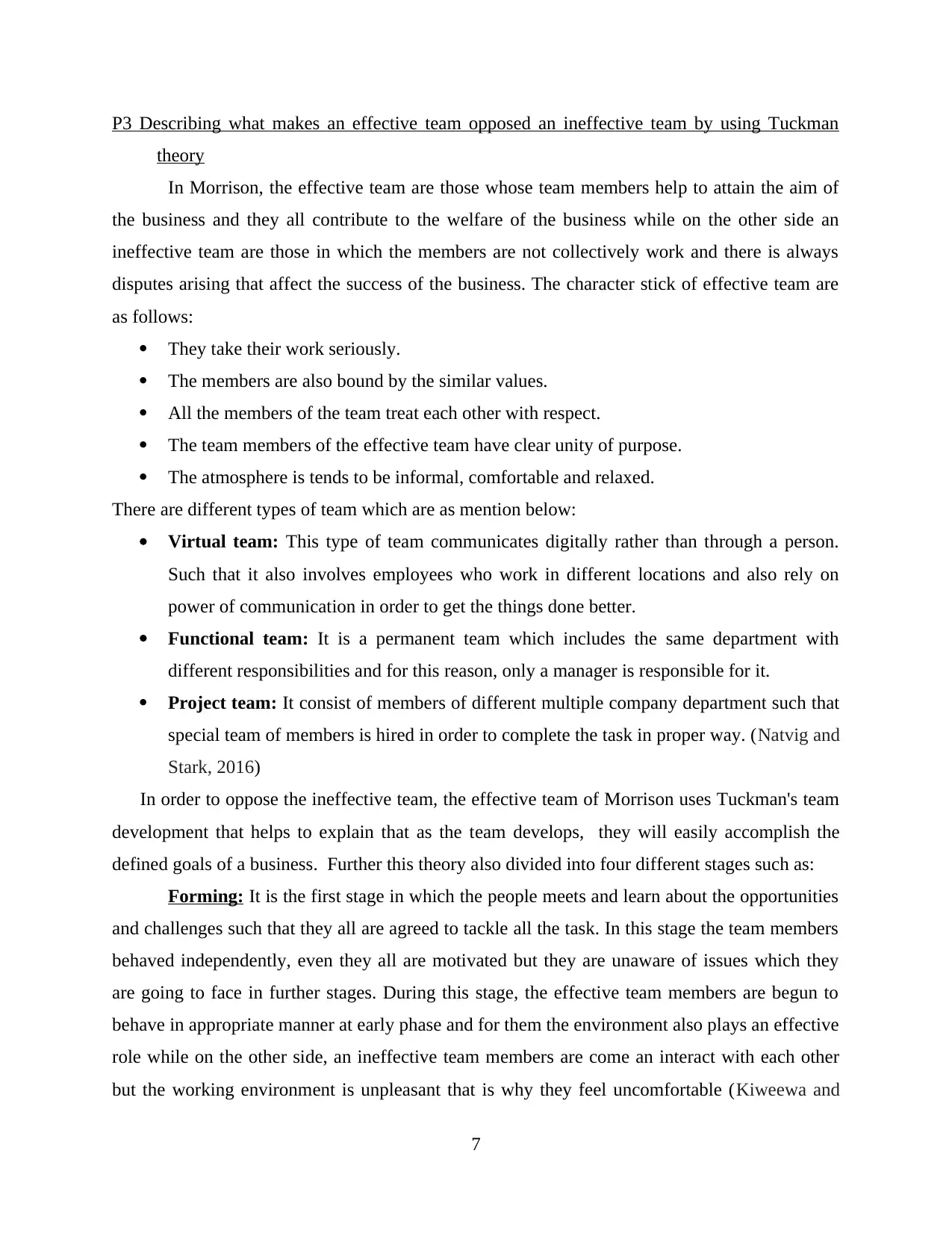
P3 Describing what makes an effective team opposed an ineffective team by using Tuckman
theory
In Morrison, the effective team are those whose team members help to attain the aim of
the business and they all contribute to the welfare of the business while on the other side an
ineffective team are those in which the members are not collectively work and there is always
disputes arising that affect the success of the business. The character stick of effective team are
as follows:
They take their work seriously.
The members are also bound by the similar values.
All the members of the team treat each other with respect.
The team members of the effective team have clear unity of purpose.
The atmosphere is tends to be informal, comfortable and relaxed.
There are different types of team which are as mention below:
Virtual team: This type of team communicates digitally rather than through a person.
Such that it also involves employees who work in different locations and also rely on
power of communication in order to get the things done better.
Functional team: It is a permanent team which includes the same department with
different responsibilities and for this reason, only a manager is responsible for it.
Project team: It consist of members of different multiple company department such that
special team of members is hired in order to complete the task in proper way. (Natvig and
Stark, 2016)
In order to oppose the ineffective team, the effective team of Morrison uses Tuckman's team
development that helps to explain that as the team develops, they will easily accomplish the
defined goals of a business. Further this theory also divided into four different stages such as:
Forming: It is the first stage in which the people meets and learn about the opportunities
and challenges such that they all are agreed to tackle all the task. In this stage the team members
behaved independently, even they all are motivated but they are unaware of issues which they
are going to face in further stages. During this stage, the effective team members are begun to
behave in appropriate manner at early phase and for them the environment also plays an effective
role while on the other side, an ineffective team members are come an interact with each other
but the working environment is unpleasant that is why they feel uncomfortable (Kiweewa and
7
theory
In Morrison, the effective team are those whose team members help to attain the aim of
the business and they all contribute to the welfare of the business while on the other side an
ineffective team are those in which the members are not collectively work and there is always
disputes arising that affect the success of the business. The character stick of effective team are
as follows:
They take their work seriously.
The members are also bound by the similar values.
All the members of the team treat each other with respect.
The team members of the effective team have clear unity of purpose.
The atmosphere is tends to be informal, comfortable and relaxed.
There are different types of team which are as mention below:
Virtual team: This type of team communicates digitally rather than through a person.
Such that it also involves employees who work in different locations and also rely on
power of communication in order to get the things done better.
Functional team: It is a permanent team which includes the same department with
different responsibilities and for this reason, only a manager is responsible for it.
Project team: It consist of members of different multiple company department such that
special team of members is hired in order to complete the task in proper way. (Natvig and
Stark, 2016)
In order to oppose the ineffective team, the effective team of Morrison uses Tuckman's team
development that helps to explain that as the team develops, they will easily accomplish the
defined goals of a business. Further this theory also divided into four different stages such as:
Forming: It is the first stage in which the people meets and learn about the opportunities
and challenges such that they all are agreed to tackle all the task. In this stage the team members
behaved independently, even they all are motivated but they are unaware of issues which they
are going to face in further stages. During this stage, the effective team members are begun to
behave in appropriate manner at early phase and for them the environment also plays an effective
role while on the other side, an ineffective team members are come an interact with each other
but the working environment is unpleasant that is why they feel uncomfortable (Kiweewa and
7
⊘ This is a preview!⊘
Do you want full access?
Subscribe today to unlock all pages.

Trusted by 1+ million students worldwide
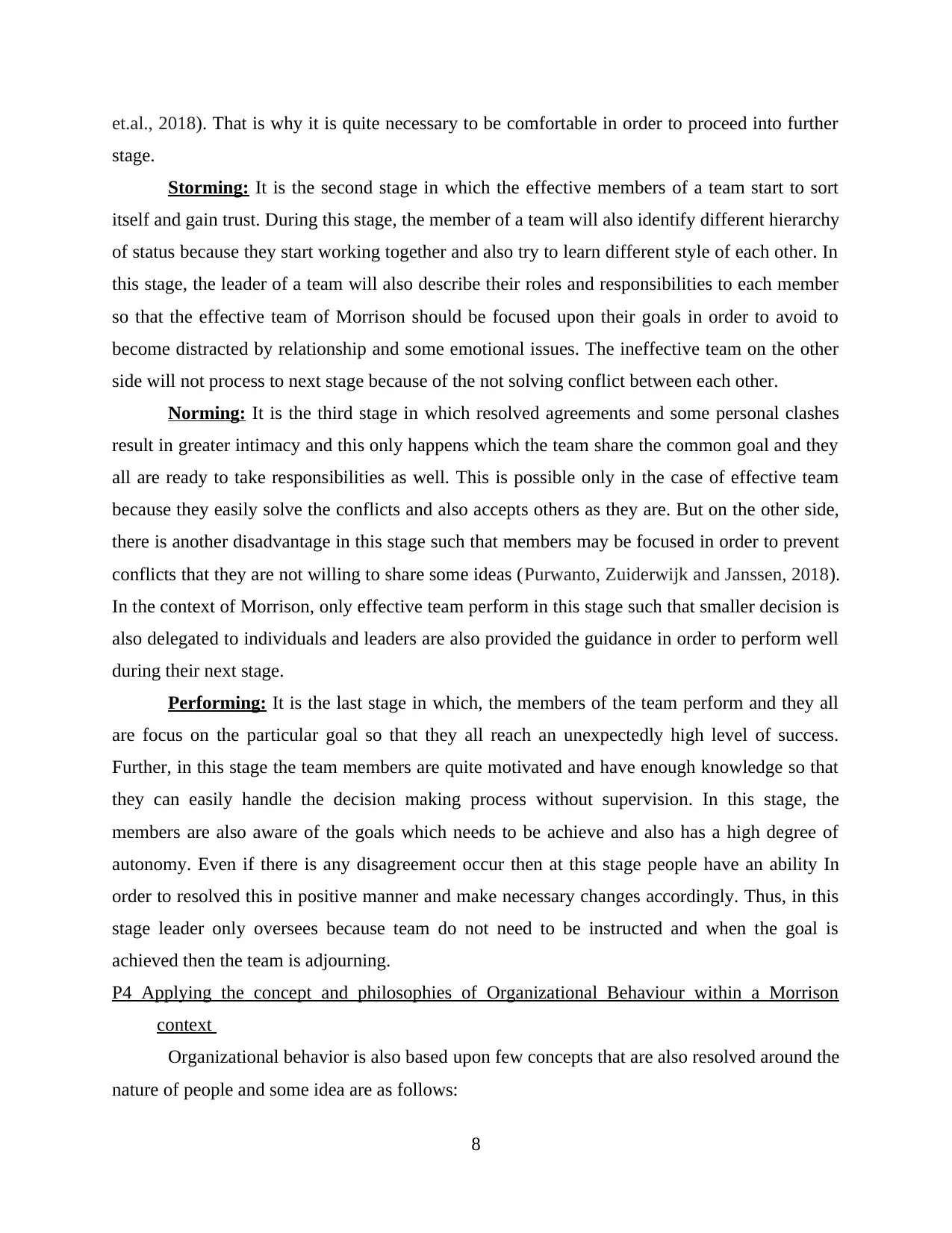
et.al., 2018). That is why it is quite necessary to be comfortable in order to proceed into further
stage.
Storming: It is the second stage in which the effective members of a team start to sort
itself and gain trust. During this stage, the member of a team will also identify different hierarchy
of status because they start working together and also try to learn different style of each other. In
this stage, the leader of a team will also describe their roles and responsibilities to each member
so that the effective team of Morrison should be focused upon their goals in order to avoid to
become distracted by relationship and some emotional issues. The ineffective team on the other
side will not process to next stage because of the not solving conflict between each other.
Norming: It is the third stage in which resolved agreements and some personal clashes
result in greater intimacy and this only happens which the team share the common goal and they
all are ready to take responsibilities as well. This is possible only in the case of effective team
because they easily solve the conflicts and also accepts others as they are. But on the other side,
there is another disadvantage in this stage such that members may be focused in order to prevent
conflicts that they are not willing to share some ideas (Purwanto, Zuiderwijk and Janssen, 2018).
In the context of Morrison, only effective team perform in this stage such that smaller decision is
also delegated to individuals and leaders are also provided the guidance in order to perform well
during their next stage.
Performing: It is the last stage in which, the members of the team perform and they all
are focus on the particular goal so that they all reach an unexpectedly high level of success.
Further, in this stage the team members are quite motivated and have enough knowledge so that
they can easily handle the decision making process without supervision. In this stage, the
members are also aware of the goals which needs to be achieve and also has a high degree of
autonomy. Even if there is any disagreement occur then at this stage people have an ability In
order to resolved this in positive manner and make necessary changes accordingly. Thus, in this
stage leader only oversees because team do not need to be instructed and when the goal is
achieved then the team is adjourning.
P4 Applying the concept and philosophies of Organizational Behaviour within a Morrison
context
Organizational behavior is also based upon few concepts that are also resolved around the
nature of people and some idea are as follows:
8
stage.
Storming: It is the second stage in which the effective members of a team start to sort
itself and gain trust. During this stage, the member of a team will also identify different hierarchy
of status because they start working together and also try to learn different style of each other. In
this stage, the leader of a team will also describe their roles and responsibilities to each member
so that the effective team of Morrison should be focused upon their goals in order to avoid to
become distracted by relationship and some emotional issues. The ineffective team on the other
side will not process to next stage because of the not solving conflict between each other.
Norming: It is the third stage in which resolved agreements and some personal clashes
result in greater intimacy and this only happens which the team share the common goal and they
all are ready to take responsibilities as well. This is possible only in the case of effective team
because they easily solve the conflicts and also accepts others as they are. But on the other side,
there is another disadvantage in this stage such that members may be focused in order to prevent
conflicts that they are not willing to share some ideas (Purwanto, Zuiderwijk and Janssen, 2018).
In the context of Morrison, only effective team perform in this stage such that smaller decision is
also delegated to individuals and leaders are also provided the guidance in order to perform well
during their next stage.
Performing: It is the last stage in which, the members of the team perform and they all
are focus on the particular goal so that they all reach an unexpectedly high level of success.
Further, in this stage the team members are quite motivated and have enough knowledge so that
they can easily handle the decision making process without supervision. In this stage, the
members are also aware of the goals which needs to be achieve and also has a high degree of
autonomy. Even if there is any disagreement occur then at this stage people have an ability In
order to resolved this in positive manner and make necessary changes accordingly. Thus, in this
stage leader only oversees because team do not need to be instructed and when the goal is
achieved then the team is adjourning.
P4 Applying the concept and philosophies of Organizational Behaviour within a Morrison
context
Organizational behavior is also based upon few concepts that are also resolved around the
nature of people and some idea are as follows:
8
Paraphrase This Document
Need a fresh take? Get an instant paraphrase of this document with our AI Paraphraser
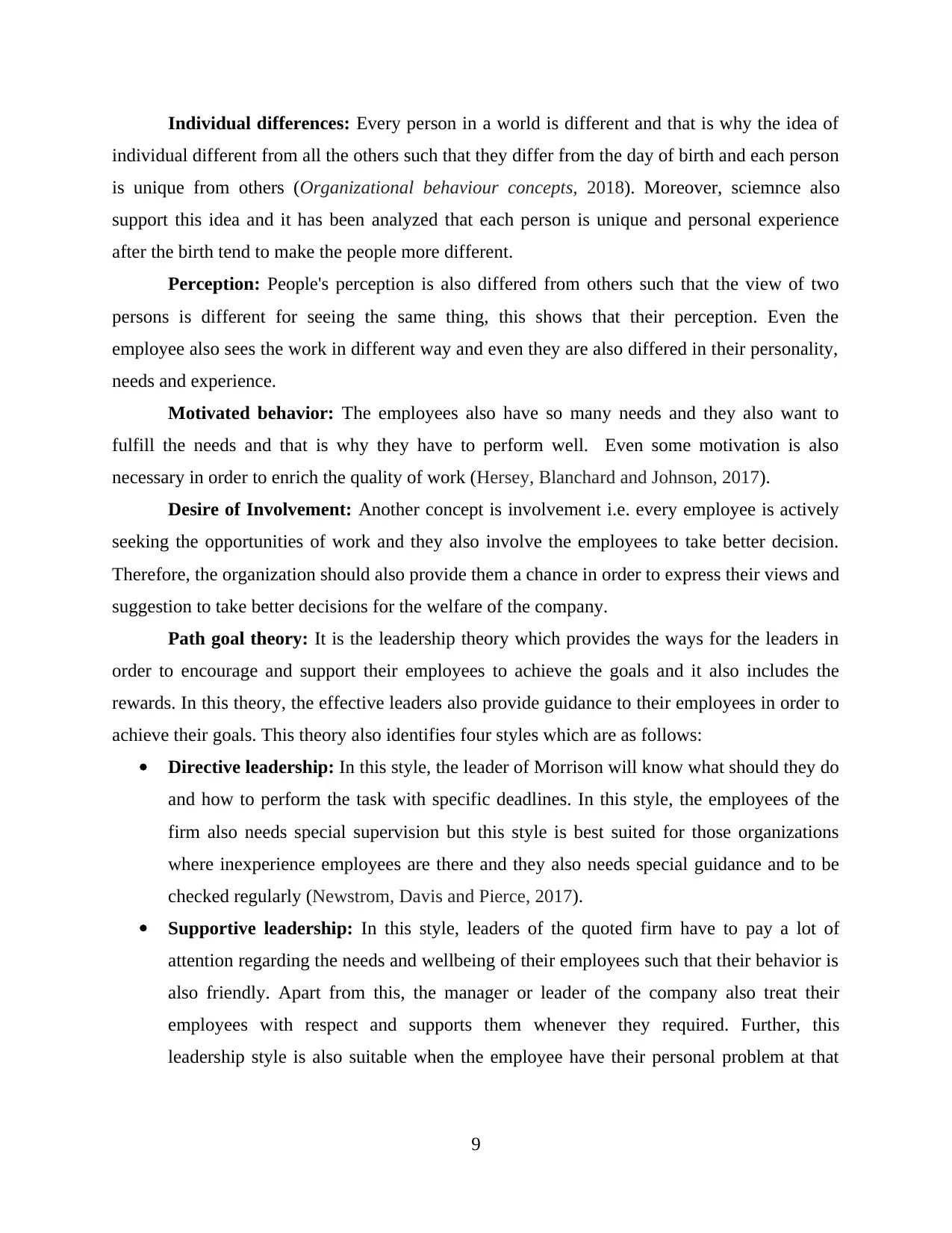
Individual differences: Every person in a world is different and that is why the idea of
individual different from all the others such that they differ from the day of birth and each person
is unique from others (Organizational behaviour concepts, 2018). Moreover, sciemnce also
support this idea and it has been analyzed that each person is unique and personal experience
after the birth tend to make the people more different.
Perception: People's perception is also differed from others such that the view of two
persons is different for seeing the same thing, this shows that their perception. Even the
employee also sees the work in different way and even they are also differed in their personality,
needs and experience.
Motivated behavior: The employees also have so many needs and they also want to
fulfill the needs and that is why they have to perform well. Even some motivation is also
necessary in order to enrich the quality of work (Hersey, Blanchard and Johnson, 2017).
Desire of Involvement: Another concept is involvement i.e. every employee is actively
seeking the opportunities of work and they also involve the employees to take better decision.
Therefore, the organization should also provide them a chance in order to express their views and
suggestion to take better decisions for the welfare of the company.
Path goal theory: It is the leadership theory which provides the ways for the leaders in
order to encourage and support their employees to achieve the goals and it also includes the
rewards. In this theory, the effective leaders also provide guidance to their employees in order to
achieve their goals. This theory also identifies four styles which are as follows:
Directive leadership: In this style, the leader of Morrison will know what should they do
and how to perform the task with specific deadlines. In this style, the employees of the
firm also needs special supervision but this style is best suited for those organizations
where inexperience employees are there and they also needs special guidance and to be
checked regularly (Newstrom, Davis and Pierce, 2017).
Supportive leadership: In this style, leaders of the quoted firm have to pay a lot of
attention regarding the needs and wellbeing of their employees such that their behavior is
also friendly. Apart from this, the manager or leader of the company also treat their
employees with respect and supports them whenever they required. Further, this
leadership style is also suitable when the employee have their personal problem at that
9
individual different from all the others such that they differ from the day of birth and each person
is unique from others (Organizational behaviour concepts, 2018). Moreover, sciemnce also
support this idea and it has been analyzed that each person is unique and personal experience
after the birth tend to make the people more different.
Perception: People's perception is also differed from others such that the view of two
persons is different for seeing the same thing, this shows that their perception. Even the
employee also sees the work in different way and even they are also differed in their personality,
needs and experience.
Motivated behavior: The employees also have so many needs and they also want to
fulfill the needs and that is why they have to perform well. Even some motivation is also
necessary in order to enrich the quality of work (Hersey, Blanchard and Johnson, 2017).
Desire of Involvement: Another concept is involvement i.e. every employee is actively
seeking the opportunities of work and they also involve the employees to take better decision.
Therefore, the organization should also provide them a chance in order to express their views and
suggestion to take better decisions for the welfare of the company.
Path goal theory: It is the leadership theory which provides the ways for the leaders in
order to encourage and support their employees to achieve the goals and it also includes the
rewards. In this theory, the effective leaders also provide guidance to their employees in order to
achieve their goals. This theory also identifies four styles which are as follows:
Directive leadership: In this style, the leader of Morrison will know what should they do
and how to perform the task with specific deadlines. In this style, the employees of the
firm also needs special supervision but this style is best suited for those organizations
where inexperience employees are there and they also needs special guidance and to be
checked regularly (Newstrom, Davis and Pierce, 2017).
Supportive leadership: In this style, leaders of the quoted firm have to pay a lot of
attention regarding the needs and wellbeing of their employees such that their behavior is
also friendly. Apart from this, the manager or leader of the company also treat their
employees with respect and supports them whenever they required. Further, this
leadership style is also suitable when the employee have their personal problem at that
9
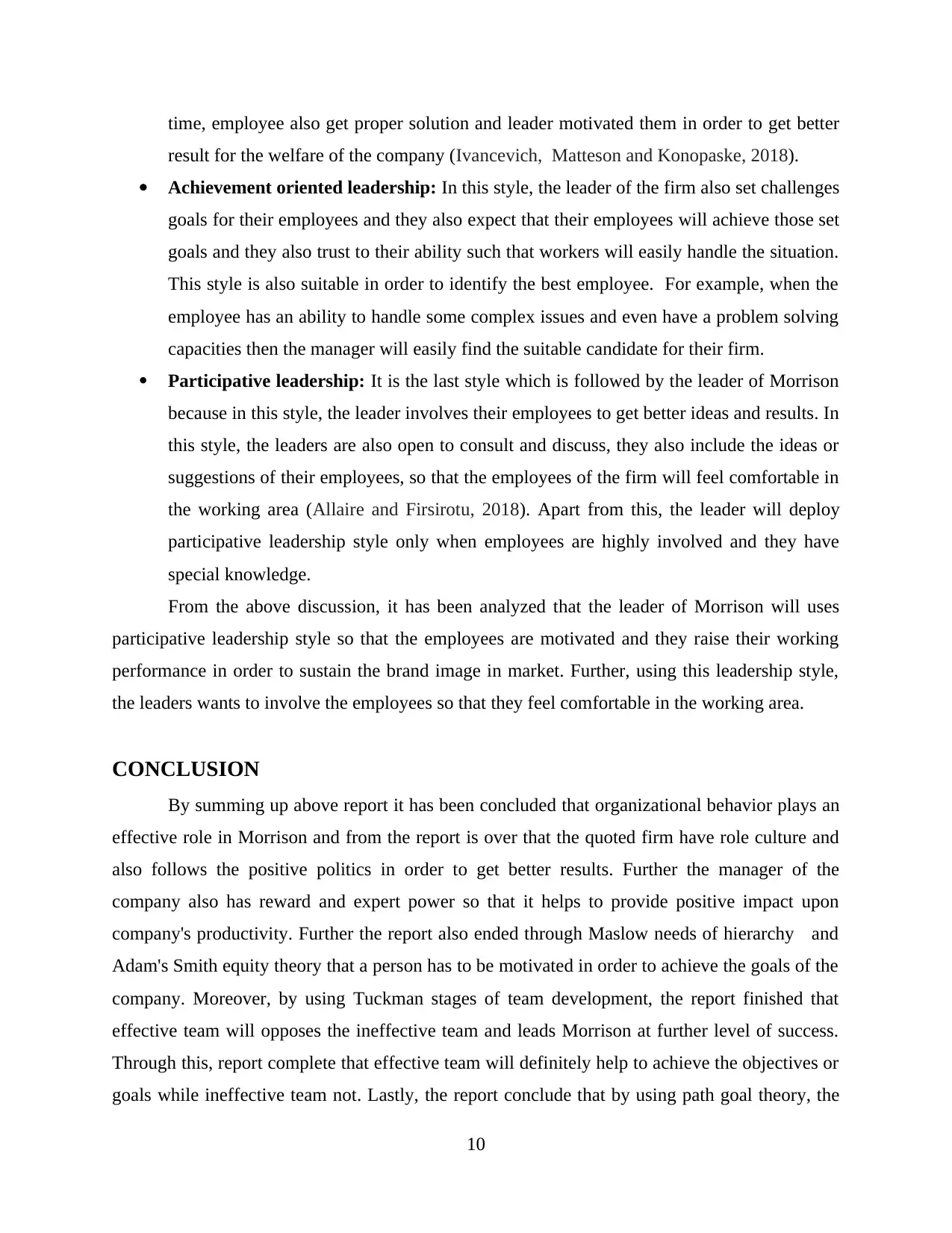
time, employee also get proper solution and leader motivated them in order to get better
result for the welfare of the company (Ivancevich, Matteson and Konopaske, 2018).
Achievement oriented leadership: In this style, the leader of the firm also set challenges
goals for their employees and they also expect that their employees will achieve those set
goals and they also trust to their ability such that workers will easily handle the situation.
This style is also suitable in order to identify the best employee. For example, when the
employee has an ability to handle some complex issues and even have a problem solving
capacities then the manager will easily find the suitable candidate for their firm.
Participative leadership: It is the last style which is followed by the leader of Morrison
because in this style, the leader involves their employees to get better ideas and results. In
this style, the leaders are also open to consult and discuss, they also include the ideas or
suggestions of their employees, so that the employees of the firm will feel comfortable in
the working area (Allaire and Firsirotu, 2018). Apart from this, the leader will deploy
participative leadership style only when employees are highly involved and they have
special knowledge.
From the above discussion, it has been analyzed that the leader of Morrison will uses
participative leadership style so that the employees are motivated and they raise their working
performance in order to sustain the brand image in market. Further, using this leadership style,
the leaders wants to involve the employees so that they feel comfortable in the working area.
CONCLUSION
By summing up above report it has been concluded that organizational behavior plays an
effective role in Morrison and from the report is over that the quoted firm have role culture and
also follows the positive politics in order to get better results. Further the manager of the
company also has reward and expert power so that it helps to provide positive impact upon
company's productivity. Further the report also ended through Maslow needs of hierarchy and
Adam's Smith equity theory that a person has to be motivated in order to achieve the goals of the
company. Moreover, by using Tuckman stages of team development, the report finished that
effective team will opposes the ineffective team and leads Morrison at further level of success.
Through this, report complete that effective team will definitely help to achieve the objectives or
goals while ineffective team not. Lastly, the report conclude that by using path goal theory, the
10
result for the welfare of the company (Ivancevich, Matteson and Konopaske, 2018).
Achievement oriented leadership: In this style, the leader of the firm also set challenges
goals for their employees and they also expect that their employees will achieve those set
goals and they also trust to their ability such that workers will easily handle the situation.
This style is also suitable in order to identify the best employee. For example, when the
employee has an ability to handle some complex issues and even have a problem solving
capacities then the manager will easily find the suitable candidate for their firm.
Participative leadership: It is the last style which is followed by the leader of Morrison
because in this style, the leader involves their employees to get better ideas and results. In
this style, the leaders are also open to consult and discuss, they also include the ideas or
suggestions of their employees, so that the employees of the firm will feel comfortable in
the working area (Allaire and Firsirotu, 2018). Apart from this, the leader will deploy
participative leadership style only when employees are highly involved and they have
special knowledge.
From the above discussion, it has been analyzed that the leader of Morrison will uses
participative leadership style so that the employees are motivated and they raise their working
performance in order to sustain the brand image in market. Further, using this leadership style,
the leaders wants to involve the employees so that they feel comfortable in the working area.
CONCLUSION
By summing up above report it has been concluded that organizational behavior plays an
effective role in Morrison and from the report is over that the quoted firm have role culture and
also follows the positive politics in order to get better results. Further the manager of the
company also has reward and expert power so that it helps to provide positive impact upon
company's productivity. Further the report also ended through Maslow needs of hierarchy and
Adam's Smith equity theory that a person has to be motivated in order to achieve the goals of the
company. Moreover, by using Tuckman stages of team development, the report finished that
effective team will opposes the ineffective team and leads Morrison at further level of success.
Through this, report complete that effective team will definitely help to achieve the objectives or
goals while ineffective team not. Lastly, the report conclude that by using path goal theory, the
10
⊘ This is a preview!⊘
Do you want full access?
Subscribe today to unlock all pages.

Trusted by 1+ million students worldwide
1 out of 15
Related Documents
Your All-in-One AI-Powered Toolkit for Academic Success.
+13062052269
info@desklib.com
Available 24*7 on WhatsApp / Email
![[object Object]](/_next/static/media/star-bottom.7253800d.svg)
Unlock your academic potential
Copyright © 2020–2025 A2Z Services. All Rights Reserved. Developed and managed by ZUCOL.




